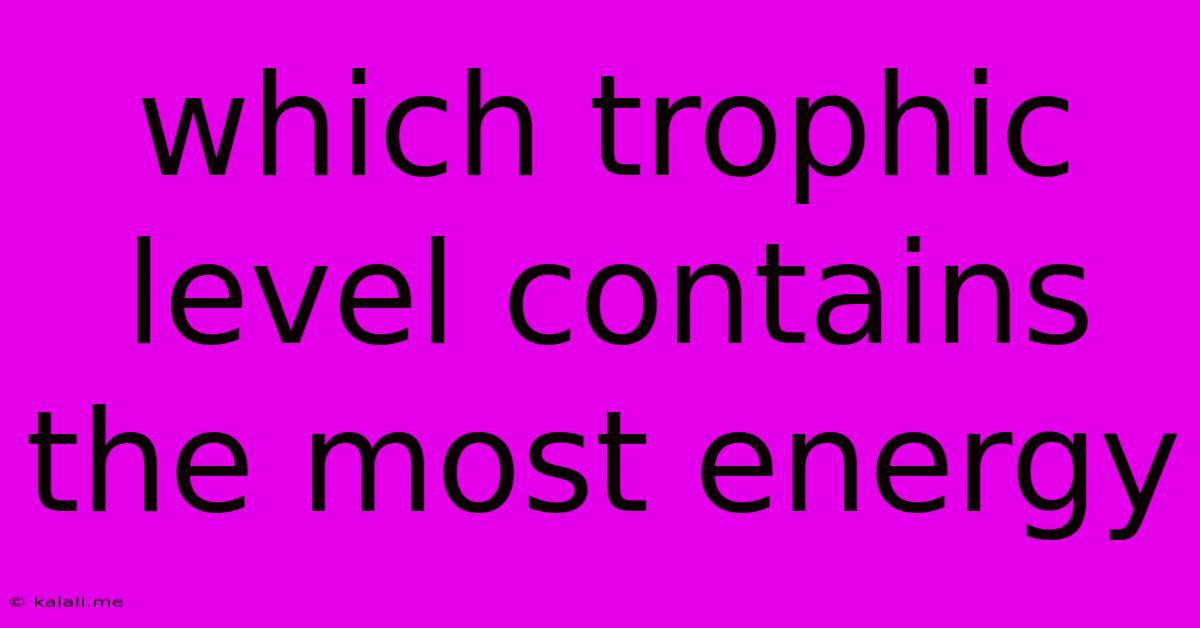Which Trophic Level Contains The Most Energy
Kalali
Jun 14, 2025 · 3 min read

Table of Contents
Which Trophic Level Contains the Most Energy? Understanding Energy Flow in Ecosystems
Meta Description: Discover which trophic level holds the most energy in an ecosystem and why. Learn about the energy pyramid, the 10% rule, and the implications for food webs and biodiversity.
The question of which trophic level contains the most energy might seem deceptively simple. However, understanding the answer requires grasping the fundamental principles of energy flow within ecosystems. The short answer is: the producers (first trophic level) contain the most energy. But let's delve deeper into why.
The Energy Pyramid and the 10% Rule
Ecosystems are structured like pyramids, with energy decreasing as you move up the trophic levels. This is visualized by the energy pyramid, a graphical representation showing the relative amounts of energy available at each level. The base of the pyramid, representing the producers (plants and other autotrophs), contains the largest amount of energy.
A crucial concept related to this is the 10% rule. This rule of thumb states that only about 10% of the energy available at one trophic level is transferred to the next. The remaining 90% is lost as heat through metabolic processes, respiration, or remains unconsumed.
Producers: The Foundation of the Ecosystem
Producers, primarily plants and algae, are autotrophs – organisms that can produce their own food through photosynthesis or chemosynthesis. They convert sunlight or chemical energy into usable organic compounds. This process captures the initial energy input into the ecosystem, making producers the foundation of the entire food web. Their abundance and high energy content are directly responsible for supporting all other trophic levels.
Consumers: The Energy Cascade
Primary consumers (herbivores) feed on producers, gaining a fraction of the producers' energy. Secondary consumers (carnivores that eat herbivores) receive even less energy, and this trend continues up the food chain. Tertiary consumers (top predators) occupy the highest trophic level, receiving the least amount of initial energy. This explains why apex predators are usually relatively rare compared to the abundance of plants and primary consumers.
Decomposers: Recycling Energy
While not usually represented in the energy pyramid in the same way, decomposers (bacteria and fungi) play a vital role in energy flow. They break down dead organic matter, releasing nutrients back into the environment, making them available for producers. This process recycles essential nutrients and completes the energy cycle within the ecosystem.
Implications for Ecosystem Health and Biodiversity
The unequal distribution of energy across trophic levels has profound implications for ecosystem health and biodiversity. A decline in the producer base, due to factors like habitat loss or climate change, would have cascading effects throughout the food web. Reduced energy availability at the base would lead to population declines at higher trophic levels, ultimately impacting biodiversity.
Understanding the energy pyramid and the 10% rule helps us appreciate the interconnectedness of species within an ecosystem and the importance of maintaining a healthy producer base for the long-term sustainability of all life. The abundance of energy at the producer level is the cornerstone of the entire ecosystem's functioning.
Latest Posts
Latest Posts
-
Electric Field Inside A Non Conducting Sphere
Jun 15, 2025
-
A Transformer Is A Device Used To
Jun 15, 2025
-
A Celestial Body That Revolves Around A Planet
Jun 15, 2025
-
The Push Or Pull On An Object Is Called
Jun 15, 2025
-
How Many Sig Figs In 500
Jun 15, 2025
Related Post
Thank you for visiting our website which covers about Which Trophic Level Contains The Most Energy . We hope the information provided has been useful to you. Feel free to contact us if you have any questions or need further assistance. See you next time and don't miss to bookmark.